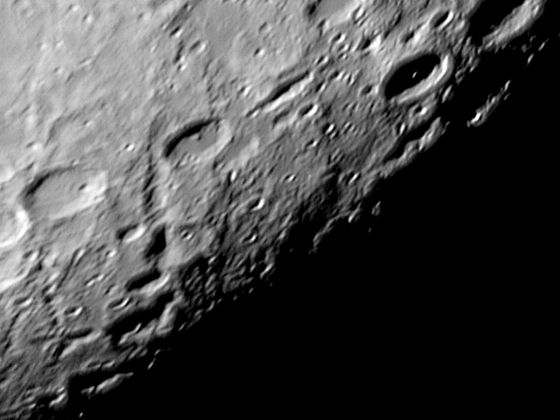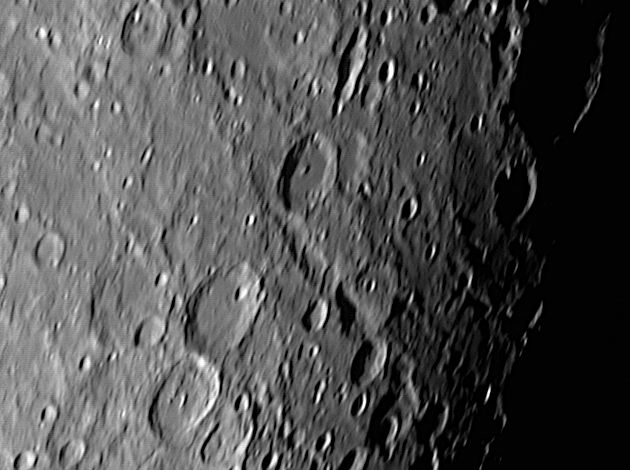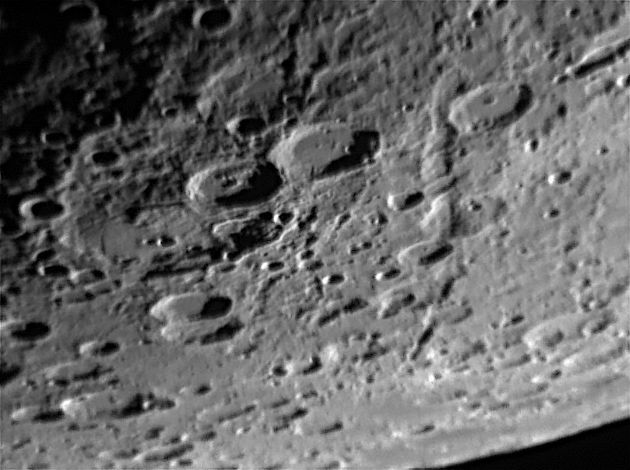

Move your mouse over the picture to see the names of the various craters.

The crater Rheita is 71 Km in diameter with walls 4000 metres high. It is situated in the rugged highlands in the Moon's south-eastern
quadrant. This is not an easy area to image. The Vallis Rheita is a string of overlapping craters
which starts on the western edge of Rheita crater and extends all the way down to the terminator,
in all about 500 Km long. I have a little more discussion of this valley here. Metius is slightly bigger than Rheita at 90 Km and is 3000 metres deep.
The picture was taken with a ToUcam attached to my LX200 on 1st September 2004,
when the Moon was 17.7 days old and the libration was almost exactly neutral.
Date and Time: 1st September 2004 23:46 UT
Camera: ToUcam 740K
Telescope: LX200 at prime focus
Capture: High gamma, 1/250", 15% gain, 313 frames
Processing: Registax. 45 frames stacked. Wavelet 1,2 = 10, 3 = 5

This is the same area and the same phase but the libration was almost as good as it gets for this part of the Moon, so the view is slightly different and more of the southern part of the Rheita valley has come into view.
The picture was taken with a ToUcam attached to my LX200 on 18th November 2005,
when the Moon was 17.6 days old.
Date and Time: 18th November 2005 21:28 UT
Camera: ToUcam 740K
Telescope: LX200 at prime focus
Capture: K3CCDTools. Low gamma, 1/25", 37% gain, 558 frames
Processing: Registax. 110 frames stacked. Wavelets 1 = 10, 2 = 5, gamma 1.2
PhotoImpact. Unsharp mask 30,5

Now a picture taken in 2022 of the region around the Rheita Valley. The same optics as above but with a more modern CCD camera, in many ways very similar to the old ToUcam. It was taken when the libration in both latitude and longitude was nearly 7°. This logitudinal libration is very favourable for this part of the Moon, but the latitudinal libration is somehat unfavourable. The scale markers are approximately 100 Km North and West.
The picture was taken with Infrared light and a DMK 21AF04 camera attached to my LX200 on 7th January 2022,
when the Moon was 5.4 days old.
Click on the image to see the image full-size (and your back button to return here).
Date and Time: 7th January 2022 17:20 UT
Camera: DMK 21AF04
Lunar Phase: 114.1°
Colongitude: 328.6°
Libration: Latitude 6° 53', Longitude 6° 53'
Telescope: LX200 at prime focus with IR-pass filter
Capture: ICCapture. 1/218", gain 1023, 3406 frames
Processing: Registax. 3320 frames stacked with drizzling ×2. Wavelets 1-2 = 40,
Focus Magic radius 7 pixels. PhotoImpact gamma 1.3, reduction to fit the page. Home Back to NE Quadrant